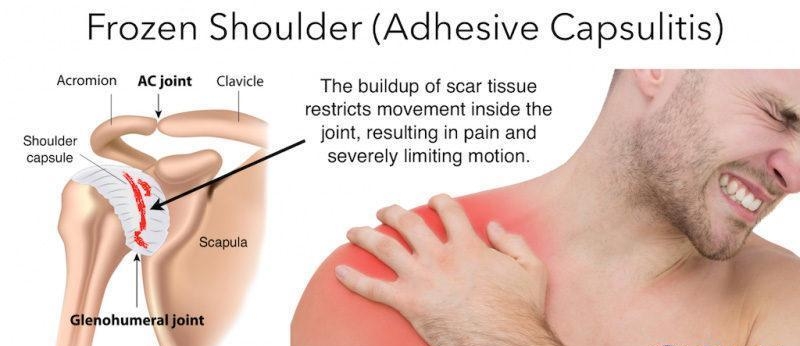Frozen Shoulder

Overview
Frozen shoulder, known medically as adhesive capsulitis, is a condition characterized by stiffness and pain in the shoulder joint. Symptoms typically begin gradually, worsen over time and then finally resolve, usually within one to three years. Frozen shoulder affects about two percent of the general population. It is most common in people between the ages of 40 and 60, and women are more likely to get it than men.
Types
There are two types of frozen shoulder: Primary (idiopathic) and Secondary.
1. Primary (idiopathic) frozen shoulder: This type occurs without a known cause. It commonly affects people on their non-dominant side.
2. Secondary frozen shoulder: This is associated with other medical conditions, including diabetes, stroke, rotator cuff injury, or after surgery or an arm fracture.
Causes
The exact cause of frozen shoulder is not fully understood, but it can occur as a result of a shoulder injury, surgery, or from a chronic medical condition such as diabetes or a stroke. The condition occurs when the flexible tissue that surrounds the shoulder joint, known as the capsule, becomes inflamed and thickened. The inflammation likely stems from immobility of the shoulder for a period, such as after surgery or an injury.
Symptoms
Symptoms of frozen shoulder can vary greatly from person to person but generally involve the following phases:
1. (“Freezing” stage) Gradual increase in pain; as pain worsens, your shoulder loses its range of motion.
2. (“Frozen” stage) Pain may begin to diminish, however, your shoulder becomes stiffer and using it becomes more difficult.
3. (“Thawing” stage) The range of motion in your shoulder begins to improve.
Diagnosis
Your doctor will likely make a diagnosis based on your symptoms and a physical exam, but imaging tests such as X-rays, MRI and ultrasound may be ordered to rule out other problems like arthritis or torn ligaments.
Treatment Options
Treatment for frozen shoulder depends on the stage and severity of the condition.
1. Physical Therapy: Physical therapists can teach you exercises to help maintain as much mobility in your shoulder as possible.
2. Medications: Over-the-counter pain relievers like ibuprofen and aspirin can help reduce pain and inflammation.
3. Injection: Injecting corticosteroids into your shoulder joint may help decrease pain and improve shoulder mobility, particularly in the early stages of the process.
4. Surgery: If conservative treatments don’t lead to improvement, your doctor might suggest surgery. It often involves cutting through tight portions of the joint capsule.
Living With Frozen Shoulder
While living with frozen shoulder can be challenging, there are ways to manage your day-to-day activities. Here are a few tips:
1. Staying active and regularly exercising your shoulder can help prevent stiffness.
2. Over-the-counter nonsteroidal anti-inflammatory drugs (NSAIDs) can ease pain.
3. Warm compresses or a hot shower can help to relieve shoulder pain.
4. Try to use the affected arm as much as possible, even in a limited manner, in daily routines.
5. Rest the shoulder at times, but not extensively to avoid limiting movement.
When to Seek Help
If you are experiencing persistent shoulder pain or stiffness that prevents you from performing everyday tasks, it’s time to seek medical attention. Seek immediate professional help if your shoulder condition is accompanied by difficulty breathing, chest tightness, or sudden arm weakness. These could be signs of a serious medical condition that requires prompt attention.
